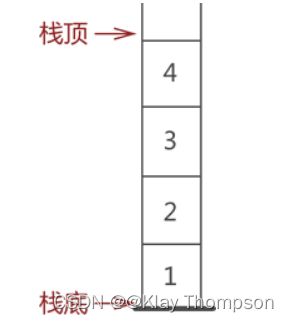【栈和队列】的特性以及基本接口的实现
目录
一、栈
1.1 栈的概念
1.2 栈的接口实现
二、队列
2.1 队列的概念
2.2 队列的接口实现
2.3 栈和队列的区别
三、栈和队列LeetCode练习
3.1 力扣_232.用栈实现队列
3.2 力扣_225.用队列实现栈
3.3 力扣_622.设计循环队列
3.4 力扣_20.有效的括号
一、栈
第一次学习数据结构的小伙伴们不要把栈想的很难,实际上挺简单的。只要搞清楚一点:“后进先出,先进后出” 就OK了!
1.1 栈的概念
对于逻辑关系为“一对一”的数据,除了用顺序表和链表存储外,还可以用栈结构存储。
栈是一种“特殊”的线性存储结构,它的特殊之处体现在以下两个地方:
1、元素进栈和出栈的操作只能从一端完成,另一端是封闭的,如下图所示:
通常,我们将元素进栈的过程简称为“入栈”、“进栈”或者“压栈”;将元素出栈的过程简称为“出栈”或者“弹栈”。
2、栈中无论存数据还是取数据,都必须遵循“先进后出”的原则,即最先入栈的元素最先出栈。以上图的栈为例,很容易可以看出是元素 1 最先入栈,然后依次是元素 2、3、4 入栈。在此基础上,如果想取出元素 1,根据“先进后出”的原则,必须先依次将元素 4、3、2 出栈,最后才能轮到元素 1 出栈。
我们习惯将栈的开口端称为栈顶,封口端称为栈底。
由此我们可以对栈存储结构下一个定义:栈是一种“只能从一端存取元素,且存取过程必须遵循‘先进后出’原则”的线性存储结构。
1.2 栈的接口实现
//Stack.h文件
#pragma once
#include
#include
#include
#include
typedef int DataType;
typedef struct Stack
{
DataType* data;
int top;
int capacity;
}ST;
//初始化栈
void STInit(ST* pst);
//入栈
void STPush(ST* pst, DataType x);
//出栈
void STPop(ST* pst);
//栈的销毁
void STDestory(ST* pst);
//得到栈顶元素
DataType STGetTop(ST* pst);
//判断栈是否为空
bool STEmpty(ST* pst);
//栈的大小——元素个数
int STSize(ST* pst); //Stack.c文件
#include "Stack.h"
void STInit(ST* pst)
{
assert(pst);
pst->data = NULL;
pst->top = 0;
pst->capacity = 0;
}
void STPush(ST* pst, DataType x)
{
assert(pst);
//扩容
if (pst->top == pst->capacity)
{
int newCapacity = pst->capacity == 0 ? 4 : pst->capacity * 2;
DataType* tmp = (DataType*)realloc(pst->data, sizeof(DataType) * newCapacity);
if (tmp == NULL)
{
perror("realloc fail!\n");
return;
}
pst->data = tmp;
pst->capacity = newCapacity;
}
//入栈
pst->data[pst->top] = x;
pst->top++;
}
void STPop(ST* pst)
{
assert(pst);
assert(!STEmpty(pst));
pst->top--;
}
void STDestory(ST* pst)
{
assert(pst);
free(pst->data);
pst->data = NULL;
pst->top = 0;
pst->capacity = 0;
}
DataType STGetTop(ST* pst)
{
assert(pst);
assert(!STEmpty(pst));
return pst->data[pst->top - 1];
}
bool STEmpty(ST* pst)
{
assert(pst);
return pst->top == 0;
}
int STSize(ST* pst)
{
assert(pst);
return pst->top;
}二、队列
2.1 队列的概念
队列用来存储逻辑关系为“一对一”的数据,是一种“特殊”的线性存储结构。和顺序表、链表相比,队列的特殊性体现在以下两个方面:
1、元素只能从队列的一端进入,从另一端出去,如下图所示:
通常,我们将元素进入队列的一端称为“队尾”,进入队列的过程称为“入队”;将元素从队列中出去的一端称为“队头”,出队列的过程称为“出队”。
2、队列中各个元素的进出必须遵循“先进先出”的原则,即最先入队的元素必须最先出队。
以上图所示的队列为例,从各个元素在队列中的存储状态不难判定,元素 1 最先入队,然后是元素 2 入队,最后是元素 3 入队。如果此时想将元素 3 出队,根据“先进先出”原则,必须先将元素 1 和 2 依次出队,最后才能轮到元素 3 出队。
2.2 队列的接口实现
//Queue.h文件
#pragma once
#include
#include
#include
#include
typedef int DataType;
typedef struct QNode
{
DataType data;
struct QNode* next;
}QNode;
typedef struct Queue
{
QNode* phead;
QNode* ptail;
int size;
}Queue;
//初始化队列
void QueueInit(Queue* pq);
//销毁队列
void QueueDestory(Queue* pq);
//入队
void QueuePush(Queue* pq, DataType x);
//出队
void QueuePop(Queue* pq);
//队头元素
DataType QueueFront(Queue* pq);
//队尾元素
DataType QueueBack(Queue* pq);
//队列的大小
int QueueSize(Queue* pq);
//判断队列是否为空
bool QueueEmpty(Queue* pq); //Queue.c文件
#include "Queue.h"
void QueueInit(Queue* pq)
{
assert(pq);
pq->phead = NULL;
pq->ptail = NULL;
pq->size = 0;
}
void QueueDestory(Queue* pq)
{
assert(pq);
QNode* cur = pq->phead;
while (cur)
{
QNode* next = cur->next;
free(cur);
cur = next;
}
pq->phead = NULL;
pq->ptail = NULL;
pq->size = 0;
}
void QueuePush(Queue* pq, DataType x)
{
assert(pq);
QNode* newnode = (QNode*)malloc(sizeof(QNode));
if (newnode == NULL)
{
perror("malloc fail!\n");
return;
}
newnode->data = x;
newnode->next = NULL;
if (pq->phead == NULL)
{
assert(pq->ptail == NULL);
pq->phead = pq->ptail = newnode;
}
else
{
pq->ptail->next = newnode;
pq->ptail = newnode;
}
pq->size++;
}
void QueuePop(Queue* pq)
{
assert(pq);
//没有节点
assert(!QueueEmpty(pq));
//只有一个节点
if (pq->phead->next == NULL)
{
free(pq->phead);
pq->phead = NULL;
pq->ptail = NULL;
}
else
{
QNode* next = pq->phead->next;
free(pq->phead);
pq->phead = next;
}
pq->size--;
}
DataType QueueFront(Queue* pq)
{
assert(pq);
assert(pq->phead);
return pq->phead->data;
}
DataType QueueBack(Queue* pq)
{
assert(pq);
assert(pq->phead);
return pq->ptail->data;
}
int QueueSize(Queue* pq)
{
assert(pq);
return pq->size;
}
bool QueueEmpty(Queue* pq)
{
assert(pq);
return pq->phead == NULL && pq->ptail == NULL;
}2.3 栈和队列的区别
栈和队列不要混淆,栈是一端开口、另一端封口,元素入栈和出栈遵循“先进后出”原则;队列是两端都开口,但元素只能从一端进,从另一端出,且进出队列遵循“先进先出”的原则。
三、栈和队列LeetCode练习
3.1 力扣_232.用栈实现队列
typedef struct {
ST PushST;
ST PopST;
} MyQueue;
MyQueue* myQueueCreate() {
MyQueue* obj = (MyQueue*)malloc(sizeof(MyQueue));
STInit(&obj->PushST);
STInit(&obj->PopST);
return obj;
}
void myQueuePush(MyQueue* obj, int x) {
STPush(&obj->PushST, x);
}
int myQueuePop(MyQueue* obj) {
int ret = myQueuePeek(obj);
STPop(&obj->PopST);
return ret;
}
int myQueuePeek(MyQueue* obj) {
if(STEmpty(&obj->PopST))
{
while(!STEmpty(&obj->PushST))
{
STPush(&obj->PopST, STGetTop(&obj->PushST));
STPop(&obj->PushST);
}
}
return STGetTop(&obj->PopST);
}
bool myQueueEmpty(MyQueue* obj) {
return STEmpty(&obj->PushST) && STEmpty(&obj->PopST);
}
void myQueueFree(MyQueue* obj) {
STDestory(&obj->PushST);
STDestory(&obj->PopST);
free(obj);
}3.2 力扣_225.用队列实现栈
typedef struct {
Queue q1;
Queue q2;
} MyStack;
MyStack* myStackCreate() {
MyStack* obj = (MyStack*)malloc(sizeof(MyStack));
QueueInit(&obj->q1);
QueueInit(&obj->q2);
return obj;
}
void myStackPush(MyStack* obj, int x) {
if(!QueueEmpty(&obj->q1))
{
QueuePush(&obj->q1, x);
}
else{
QueuePush(&obj->q2, x);
}
}
int myStackPop(MyStack* obj) {
Queue* EmptyQ = &obj->q1;
Queue* NoEmptyQ = &obj->q2;
if(!QueueEmpty(&obj->q1))
{
EmptyQ = &obj->q2;
NoEmptyQ = &obj->q1;
}
while(QueueSize(NoEmptyQ) > 1)
{
QueuePush(EmptyQ, QueueFront(NoEmptyQ));
QueuePop(NoEmptyQ);
}
int top = QueueFront(NoEmptyQ);
QueuePop(NoEmptyQ);
return top;
}
int myStackTop(MyStack* obj) {
if(!QueueEmpty(&obj->q1))
{
return QueueBack(&obj->q1);
}
else
{
return QueueBack(&obj->q2);
}
}
bool myStackEmpty(MyStack* obj) {
return QueueEmpty(&obj->q1) && QueueEmpty(&obj->q2);
}
void myStackFree(MyStack* obj) {
QueueDestory(&obj->q1);
QueueDestory(&obj->q2);
free(obj);
}3.3 力扣_622.设计循环队列
typedef struct {
int front;
int rear;
int k;
int* a;
} MyCircularQueue;
MyCircularQueue* myCircularQueueCreate(int k) {
MyCircularQueue* obj = (MyCircularQueue*)malloc(sizeof(MyCircularQueue));
obj->a = (int*)malloc(sizeof(int) * (k + 1));
if(obj == NULL)
{
perror("malloc fail!\n");
return NULL;
}
obj->front = obj->rear = 0;
obj->k = k;
return obj;
}
bool myCircularQueueIsFull(MyCircularQueue* obj) {
return (obj->rear + 1) % (obj->k + 1) == obj->front;
}
bool myCircularQueueIsEmpty(MyCircularQueue* obj) {
return obj->front == obj->rear;
}
bool myCircularQueueEnQueue(MyCircularQueue* obj, int value) {
if(myCircularQueueIsFull(obj))
return false;
obj->a[obj->rear] = value;
obj->rear++;
obj->rear %= (obj->k+1);
return true;
}
bool myCircularQueueDeQueue(MyCircularQueue* obj) {
if(myCircularQueueIsEmpty(obj))
{
return false;
}
obj->front++;
obj->front %= (obj->k+1);
return true;
}
int myCircularQueueFront(MyCircularQueue* obj) {
if(!myCircularQueueIsEmpty(obj))
return obj->a[obj->front];
else
return -1;
}
int myCircularQueueRear(MyCircularQueue* obj) {
if(!myCircularQueueIsEmpty(obj))
return obj->a[(obj->rear + obj->k) % (obj->k + 1)];
else
return -1;
}
void myCircularQueueFree(MyCircularQueue* obj) {
free(obj->a);
free(obj);
}3.4 力扣_20.有效的括号
bool isValid(char * s)
{
ST st;
STInit(&st);
while(*s)
{
if(*s == '(' || *s == '[' || *s == '{')
{
STPush(&st, *s);
}
else
{
if(STEmpty(&st))
{
STDestory(&st);
return false;
}
char top = STGetTop(&st);
STPop(&st);
if(*s == ')' && top != '('
|| *s == ']' && top != '['
|| *s == '}' && top != '{')
{
STDestory(&st);
return false;
}
}
s++;
}
bool ret = STEmpty(&st);
STDestory(&st);
return ret;
}




